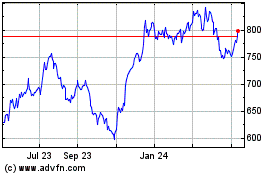Headwinds Intensify As Risky CMBS Buyers Bristle Over Loans
July 26 2011 - 4:02PM
Dow Jones News
A key funding source that has made the commercial
mortgage-backed securities revival possible may back further away
from the market in coming months, leaving lenders to scramble for
other buyers or watch their volume fizzle.
Some players in the small but powerful group of investors that
support the riskiest parts of bonds backed by office, retail and
apartment buildings are finding a troublesome trend in the loans
that they are offered.
Weaker underwriting standards including a higher percentage of
interest only loans and structures that strip some control from
investors have been pitched to these investors more frequently in
recent months, some of the so-called "B-piece" buyers said. The
trend accelerated as more lenders re-entered the market in 2011,
boosting competition to make loans in a market still challenged by
the fragile economic recovery.
At fewer than six active firms, the field of B-piece buyers is
half that of 2007, limiting growth, according to Standard &
Poor's. CMBS issuance is a fraction of its $234 billion 2007 peak,
but B-piece buyers today must support more of each deal and will
likely have to bear risks longer under new financial
regulation.
The average sub-investment grade portion of a CMBS issue that
the buyers must pick up has nearly doubled since 2007 to about
5.8%, S&P said.
"Eight weeks ago there were four deals out for the bid ...
that's a lot in a market with only three or four active,
experienced B-piece buyers," said Steven Schwartz, managing
director at Torchlight Investors.
"If you can't find one of those guys, you're going to have to
find someone new and that's potentially a problem," said Schwartz,
who spent 19 years in commercial property lending and CMBS at J.P.
Morgan Chase & Co. (JPM). "That's going to be a limitation for
the CMBS market."
B-piece buyers include BlackRock Inc., (BLK) the world's largest
money manager, and real estate firms Rialto Capital Management and
Torchlight. Hedge funds H/2 Capital Partners and Elliott Management
also buy subordinated debt.
CMBS volume topped $20 billion last week, on pace to meet
industry estimates for a $35 billion to $40 billion market, up from
$15.3 billion in 2010 and $3 billion in 2009. The outlook could be
too optimistic, however, with weaker collateral and market
volatility resulting in higher costs for issuers, Lisa Pendergast,
co-head of CMBS risk and strategy at Jefferies & Co., said in a
research note on Friday.
Resistance isn't limited to B-piece buyers, with Goldman Sachs
Group Inc. (GS) and Citigroup Inc. (C) last week sweetening a $1.48
billion CMBS for senior investors unhappy with low yields and
credit support. Investors globally are also reassessing risk
appetites amid concern over European and U.S. sovereign debt
defaults.
Whether dislike of loans, lack of capacity or regulation,
headwinds for lending comes at a time when the U.S. property market
is still struggling in many regions outside large cities, where
employment has stabilized. The availability of credit has smoothed
the transition for many borrowers with loans made at the height of
the real estate bubble and who now have to refinance, or lose their
investment.
"It's going to be felt by the commercial real estate industry as
a whole because a very important source of capital is going to
become much more costly and much less available, and that's going
to have a ripple effect," said Ethan Penner, president of CBRE
Capital Partners who pioneered CMBS in the 1990s.
As in the heydey of 2007, B-piece buyers are being asked to take
more risk for the same return, three of those investors said. That
includes positions in mortgages on which they lack control of
servicing, or accepting deals in which they could shoulder losses
for a loan not included when calculating their risk, one industry
source said.
With that in mind, investors may turn to distressed assets as
they emerge, including Anglo Irish Bank Corp.'s $9.5 billion U.S.
real estate portfolio currently out for bid, said a B-piece buyer
who declined to be named.
The trend increases chances that loans won't get placed into a
CMBS as anticipated, putting lenders in a bind. For now, lenders
are finding outlets.
"I can say all I want that 'I don't like that,' and what happens
is there are other non-traditional buyers that have raised money,
and are looking for a home for it," said Daniel Sefcik, a managing
director at BlackRock, which he said has been outbid on deals by
more aggressive investors.
"We were a big buyer early on and then we kind of backed off,
and had people ask if we are out of the market," he said. "We have
been bidding, we just haven't been winning."
-By Al Yoon, Dow Jones Newswires; 212-416-3216;
albert.yoon@dowjones.com
BlackRock (NYSE:BLK)
Historical Stock Chart
From May 2024 to Jun 2024

BlackRock (NYSE:BLK)
Historical Stock Chart
From Jun 2023 to Jun 2024
